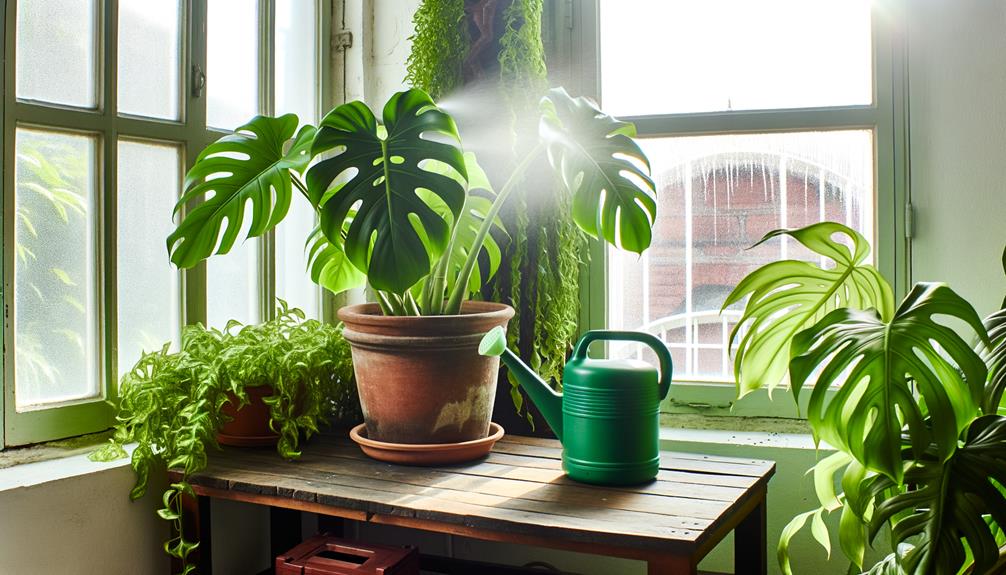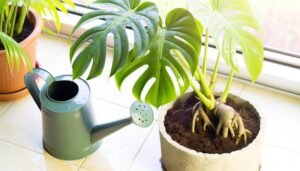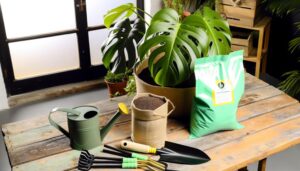Monstera Siltepecana Indoor Care
To care for Monstera Siltepecana indoors, place it in bright, indirect light, such as near a north or east-facing window. Provide well-draining soil with a mix of peat moss, perlite, and orchid bark.
Water when the top inch of soil is dry and maintain humidity levels between 60% and 80%. Use a balanced, water-soluble fertilizer every 4-6 weeks during the growing season.
Regularly check for pests like spider mites, aphids, and mealybugs, treating promptly if found. Prune damaged leaves and elongated stems to promote healthy growth.
Follow these steps, and you'll be prepared to uncover more advanced care tips.

Key Takeaways
- Place in bright, indirect light near a north or east-facing window to prevent leaf scorch.
- Water when the top 2-3 inches of soil are dry to avoid overwatering and root rot.
- Use a well-draining soil mix with peat moss, perlite, and orchid bark in equal parts.
- Maintain humidity levels between 60%-80% using a humidifier or water-filled tray with pebbles.
- Fertilize every 4-6 weeks with a balanced, water-soluble fertilizer during the growing season.
Ideal Lighting Conditions
For best growth, place your Monstera Siltepecana in bright, indirect light to mimic its natural understory habitat. Direct sunlight can scorch its leaves, causing chlorosis and stunted growth. Position it near a north or east-facing window, where it will receive diffused light.
If natural light is insufficient, you can supplement with fluorescent grow lights or LED lights, ensuring they emit a spectrum that includes blue and red wavelengths. Keep the light source at least 12 inches away from the plant to prevent heat damage.
Monitor the plant's response; leggy growth indicates insufficient light, while yellowing suggests overexposure. By adjusting light conditions, you'll optimize photosynthesis and maintain lush, vibrant foliage.
Watering Guidelines
To maintain a healthy Monstera Siltepecana, water it when the top inch of soil feels dry.
Be sure you're familiar with signs of overwatering, such as yellowing leaves and root rot.
Consistently monitor soil moisture to strike the right balance for best growth.
Optimal Watering Frequency
Promoting the health of your Monstera Siltepecana requires you to water it consistently but sparingly, as overwatering can lead to root rot. Aim to water when the top 2-3 inches of soil feel dry to the touch. Use a moisture meter for precise measurement.
During the growing season (spring and summer), you may need to water every 7-10 days. In the dormant season (fall and winter), reduce the frequency to every 14-21 days. Make sure the pot has drainage holes to prevent waterlogging.
Use room-temperature, filtered water to avoid shocking the plant. Apply water until it drains from the bottom, then empty the saucer to prevent standing water. This method promotes ideal root oxygenation and nutrient uptake.
Signs of Overwatering
Overwatering your Monstera Siltepecana can manifest through several telltale signs, including yellowing leaves, mushy stems, and a musty smell emanating from the soil. These symptoms indicate root rot, a condition where waterlogged roots can't absorb oxygen.
To diagnose, gently remove the plant from its pot and inspect the roots. Healthy roots are white and firm, while overwatered roots appear brown and slimy. If overwatering is confirmed, trim the affected roots with sterile scissors. Repot the plant using fresh, well-draining soil and a container with drainage holes.
Adjust your watering schedule, ensuring the top 1-2 inches of soil dry out between waterings. Monitor closely for recovery signs, such as new growth and improved leaf color.
Soil Requirements
A well-draining, nutrient-rich soil mix is crucial for Monstera Siltepecana to thrive indoors. You'll want a substrate that combines organic matter for nutrients and aeration components to prevent root rot.
Mix equal parts of peat moss, perlite, and orchid bark to achieve this balance. Peat moss retains moisture without waterlogging the roots, while perlite and orchid bark enhance drainage and provide aeration.
Avoid heavy garden soils as they compact easily, reducing oxygen availability. Regularly check the soil's pH, aiming for a slightly acidic range of 5.5 to 6.5. You can incorporate a slow-release, balanced fertilizer to guarantee a steady supply of essential nutrients.
Consistency in soil composition will help your Monstera Siltepecana flourish.
Humidity Needs
Maintaining high moisture levels, ideally between 60% and 80%, is vital for the optimal growth of Monstera Siltepecana. Use a hygrometer to monitor ambient moisture around your plant.
If levels fall below 60%, increase moisture using a humidifier, or place a water-filled tray with pebbles beneath the pot. Grouping plants together can also create a microenvironment with higher moisture.
Mist the leaves regularly, but avoid over-wetting to prevent fungal infections. Ensure good air circulation to reduce the risk of mold.
If your home's climate is dry, especially during winter, consider placing the plant in a bathroom or kitchen where moisture is naturally higher. Consistent moisture is essential for maintaining the plant's vibrant foliage and overall health.
Fertilization Tips
After maintaining proper humidity, you should focus on providing Monstera Siltepecana with a balanced, water-soluble fertilizer every 4-6 weeks during the growing season to support robust development. Choose a fertilizer with an N-P-K ratio of 20-20-20 or 10-10-10, making sure it contains micronutrients like iron, magnesium, and calcium.
Dilute the fertilizer to half the recommended strength on the package to prevent nutrient burn. Apply the solution evenly to moist soil, avoiding direct contact with foliage. Monitor plant response to adjust frequency or concentration as needed.
During the dormant winter months, reduce fertilization frequency to once every 8-10 weeks or cease altogether, as the plant's growth rate slows significantly. This approach promotes optimal nutrient uptake and healthy growth.
Common Pests
Despite their resilience, Monstera Siltepecana plants can fall prey to common pests like spider mites, aphids, and mealybugs, which require diligent monitoring and prompt action.
Inspect your plant regularly, focusing on the undersides of leaves and stems. At the first sign of infestation, isolate the affected plant to prevent spreading.
Use a diluted neem oil solution or insecticidal soap to treat the pests, applying thoroughly to all plant surfaces. For spider mites, increase humidity levels as they thrive in dry conditions.
Aphids can be removed with a strong jet of water. Mealybugs, characterized by their cotton-like appearance, require manual removal using cotton swabs dipped in alcohol.
Consistent monitoring guarantees your Monstera remains healthy and pest-free.
Pruning and Maintenance
Regular trimming and upkeep are crucial to safeguard the vitality of your Monstera Siltepecana and foster healthy growth. Begin by sterilizing pruning shears using isopropyl alcohol to prevent the spread of pathogens.
Prune away any yellowing, damaged, or diseased leaves to redirect energy to healthier areas. Trim elongated stems just above a node to stimulate denser growth. Routinely clean leaves with a moist cloth to eliminate dust and aid in photosynthesis.
Check for aerial roots and, if needed, trim them to preserve visual appeal. Throughout the growth period, consider monthly applications of a balanced, water-soluble fertilizer. Watch out for indications of excessive fertilization, like leaf scorch, and make adjustments as necessary.
Diligent attention guarantees that your Monstera Siltepecana flourishes, displaying its appealing foliage.
Conclusion
Caring for your Monstera siltepecana is like nurturing a tiny rainforest in your living room. With the right balance of light, water, soil, and humidity, your plant will thrive.
Think of it as fine-tuning an instrument; every detail matters. Remember, a well-fed Monstera produces lush, vibrant leaves, much like a well-tended garden flourishes.
Keep an eye out for pests and regularly prune to maintain its beauty. Your diligence will be rewarded with a stunning, healthy plant.






